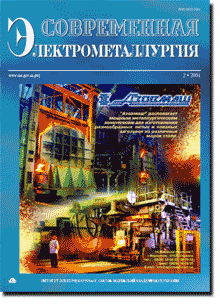

ELECTROSLAG TECHNOLOGY
Kompan Ya.Yu., Protokovilov I.V. and Moiseev V.N. High-strength and heat-resistant titanium alloys with intermetallics produced by MEM technology. P. 2
New class of high-strength and heat-resistant titanium alloys, based on a- and b-solid solutions with a phase in the form of chemical compound, is offered. To produce these alloys a method of magnetically-controlled electroslag melting (MEM) is used. Results of investigations of mechanical properties and structure of solid-solution titanium alloys with an intermetallic strengthening are given.
Popov V.S., Bilonik I.M., Berezhny S.P. and Kapustyan A.E. Improvement of structure and properties of cast tool steels in electroslag melting with inoculators. P. 7
It is shown that the method of electroslag melting with adding of inoculators into a molten metal pool allows increase greatly the structure dispersity and mechanical properties of cast tool steels. The effect of size and amount of added inoculators on structure and properties of cast steels R6M5 and Kh12M of electroslag melting was studied.
ELECTRON BEAM PROCESSES
Movchan B.A. and Yakovchuk K.Yu. Electron beam installations for evaporation and deposition of inorganic materials and coatings. P. 9
Technical characteristics and design features of electron beam installations, designed at the International Center for Electron Beam Technologies of the E.O. Paton Electric Welding Institute and used for producing materials and coatings by electron beam evaporation and subsequent condensation in vacuum are presented. The ways for further development and improvement of electron beam equipment, connected with implementation of new technological processes in machine-building, are considered.
Trigub N.P., Zhuk G.V., Akhonin S.V. and Berezos V.A. Electron beam technology of producing tubular billets from zirconium-base alloy. P. 15
Technology of production of hollow ingots from zirconium alloy using the method of electron beam intermediate crucible melting has been developed. Optimum technological parameters of melting were determined by the methods of mathematical simulation. Chemical composition and mechanical properties of tubular billets were investigated.
Khomutsky S.V., Kozlovets O.N. and Ishchenko V.V. Producing of high-quality copper ingots from industrial wastes using electron beam remelting with intermediate crucible. P. 17
Technology for producing ingots of high-quality copper from industrial wastes using electron beam remelting with an intermediate crucible is described. Design of the intermediate crucible is given. The offered technology makes it possible to melt high-quality copper ingots of diameter from 100 to 300 mm and up to 2 m length. The data are presented about structure, chemical composition and mechanical properties of copper ingots.
Nakonechny N.F., Fyodorov V.N. and Shchekin-Krotov V.A. Metal temperature at consumable billet downward slope in EBICM of titanium alloys. P. 19
Procedure of calculation of temperature of metal, flowing down from the consumable billet slope in electron beam intermediate crucible remelting of VT1-0 titanium alloys, is described. It is shown that with increase in remelting efficiency from 0.078 to 0.148 kg/s the temperature of metal overheating above liquidus was increased from 31-55 up to 93-172 oC.
VACUUM-INDUCTION MELTING
Shejko I.V. and Grigorenko G.M. Induction heating. Capabilities and prospects of application in special electrometallurgy processes. Part 3. Induction remelting in a sectional mould. P. 23
Review and analysis of capabilities and practical application of experimental-industrial installations for induction remelting in a sectional mould (IRSM) and technology of refining remelting of wastes of different metals and alloys are presented. It is shown that the mechanism of transfer of electromagnetic field energy to the charge is differed from conventional induction heating, as a water-cooled wall of the sectional mould is located between the inductor and charge, that distorts the electromagnetic field in the melting zone and plays a role of an inductor for the charge. The IRSM process is characteristic of pressing out the metallic melt from the mould wall in the zone limited by the inductor height. Owing to this, the heat losses are reduced drastically, and the intensive circulation of the melt promotes the equalizing of temperature and chemical composition in the pool volume, contributes to the escape of non-metallic inclusions and gas impurities to the melt surface.
Sojfer V.M. Some specifics in safety of induction furnaces. P. 29
Problems encountered with occurrence of electromagnetic fields in operation of induction furnaces are considered. Measures for protection of workers from the action of electromagnetic fields are described, namely proper selection of type of furnaces, presence of screening magnetic cores, indication of distance of workers location from the furnace in technological instructions and keeping this distance. Standards of magnetic field intensity, existing in different countries, are given.
GENERAL PROBLEMS OF METALLURGY
Prikhodko E.V. and Moroz V.F. About effect of interatomic interaction in melts on solubility of gases and carbon in them. Part 1. Methodology of investigation. Solubility of carbon and nitrogen. P. 32
Using models of metal melts with BCC-like structure, the solubility of carbon, hydrogen, nitrogen, oxygen and other gases in metal and salt solutions was studied. Close correlation relations of solubility with integral parameters of interatomic interaction were established which allow numerical prediction of solubility of gases and carbon in metal and salt melts of different composition.
ENERGY AND RESOURCE SAVING
Lakomsky V.I. Contact heat conductivity of crushed thermoanthracite. P. 42
The feasibility is shown for use of R. Holm's conception about the real contact spots of two contacting solid bodies to obtain the analytical dependence of a coefficient of external heat conductivity of bulk material on internal its heat conductivity and fractional composition and to calculate the value of a coefficient of external heat conductivity using the known values of specific electric resistance.
Teslevich S.M., Telin V.V., Petrunko A.N., Shvartsman L.Ya. and Yatsenko A.P. Problems of safety of unit of an increased cycle efficiency for magnesium-thermic producing of spongy titanium. P. 45
Results of works on the creation and testing the 3.8 t cycle efficiency unit for magnesium-thermic producing of spongy titanium, designed for reconstruction of titanium production of Zaporozhie titanium-magnesium plant, are presented. Problems of reliability in designing, manufacture and service of the unit are considered.
INFORMATION
Theses for scientific degree. P. 49
(You are viewing the simplified file contents)
The cost of subscription/purchase order journals or individual articles
| Journal/Currency | Annual Set | 1 issue printed |
1 issue |
one article |
| TPWJ/USD | 384 $ | 32 $ | 26 $ | 13 $ |
| TPWJ/EUR | 348 € | 29 € | 24 € | 12 € |
| TPWJ/UAH | 7200 UAH | 600 UAH | 600 UAH | 280 UAH |
| AS/UAH | 1800 UAH | 300 UAH | 300 UAH | 150 UAH |
| AS/USD | 192 $ | 32 $ | 26 $ | 13 $ |
| AS/EUR | 180 € | 30 € | 25 € | 12 € |
| SEM/UAH | 1200 UAH | 300 UAH | 300 UAH | 150 UAH |
| SEM/USD | 128 $ | 32 $ | 26 $ | 13 $ |
| SEM/EUR | 120 € | 30 € | 25 € | 12 € |
| TDNK/UAH | 1200 UAH | 300 UAH | 300 UAH | 150 UAH |
| TDNK/USD | 128 $ | 32 $ | 26 $ | 13 $ |
| TDNK/EUR | 120 € | 30 € | 25 € | 15 € |
AS = «Automatic Welding» - 6 issues per year;
TPWJ = «PATON WELDING JOURNAL» - 12 issues per year;
SEM = «Electrometallurgy Today» - 4 issues per year;
TDNK = «Technical Diagnostics and Non-Destructive Testing» - 4 issues per year.





